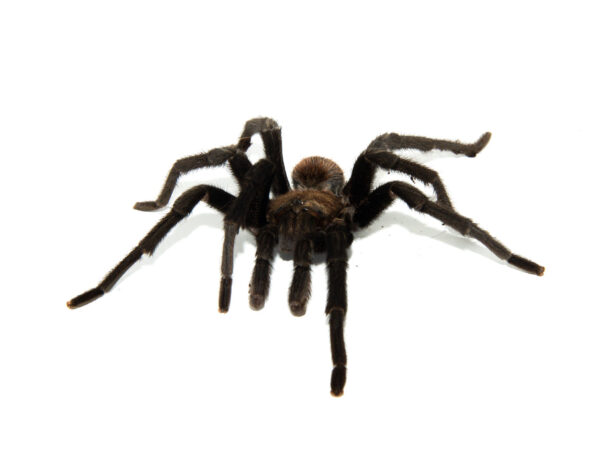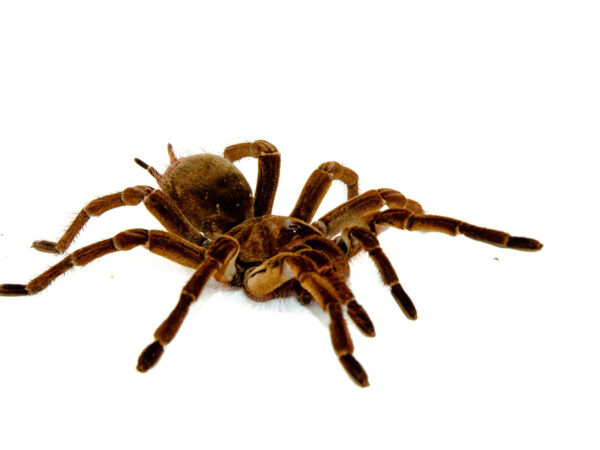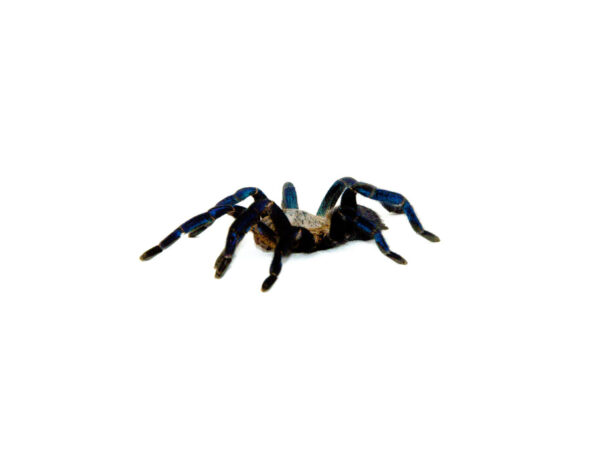Striped Knee Tarantulas (Aphonopelma seemanni): Speed and Beauty in One Spider
Striped Knee Tarantulas (Aphonopelma seemanni) are one of the most visually striking species available to hobbyists. Known for their distinctive white striping across the knees and velvety dark brown or black bodies, they are commonly referred to as the Costa Rican Zebra Tarantula. This terrestrial species is admired not just for its looks but also for its energetic behavior and manageable care requirements.
Native to Central America, particularly Costa Rica and Nicaragua, the Striped Knee Tarantula prefers warm, humid conditions and is frequently found in forest floors and underground burrows. It’s a tarantula that catches your eye and keeps your attention.
Appearance and Size
The signature look of the Striped Knee Tarantula (Aphonopelma seemanni) is its bold white stripes that contrast against dark brown or black legs. These markings give it a dramatic, zebra-like appearance. The body can reach up to 6 inches in leg span when fully grown, making it a medium-to-large tarantula.
In some morphs, the body appears more bronze or bluish depending on the lighting, adding to the visual appeal.
Behavior and Temperament
While not considered aggressive, Striped Knee Tarantulas are known for being fast and sometimes skittish. They may dart quickly when disturbed, making them less ideal for handling but perfect for observation. They rarely bite, but will occasionally flick urticating hairs if threatened.
This is a species best appreciated in a secure, escape-proof enclosure, where its active nature and impressive burrowing behaviors can be observed.
Housing Requirements
Providing a proper setup for your Striped Knee is key to its health and longevity:
-
Enclosure Size: A 10–15 gallon terrarium works well for an adult.
-
Substrate: Use 4–6 inches of coconut fiber or topsoil to allow for burrowing.
-
Temperature: Maintain between 75–80°F with minimal fluctuations.
-
Humidity: Keep humidity between 65–75%, using occasional misting and a water dish.
-
Hides: Include a cork bark slab, half log, or artificial cave for hiding.
Good ventilation is essential to avoid mold growth, especially in a humid environment.
Feeding and Molting
Striped Knee Tarantulas are eager eaters. They will readily accept:
-
Crickets
-
Dubia roaches
-
Mealworms and superworms (occasionally)
Feed adults every 7–10 days, and juveniles every 3–5 days. Remove uneaten food after 24 hours. Like most tarantulas, they will stop eating and become more reclusive during pre-molt. It’s important to avoid handling during this period.
Males mature faster and have shorter lifespans (4–6 years), while females can live up to 15–20 years with proper care.
Why Choose a Striped Knee Tarantula?
The Striped Knee Tarantula (Aphonopelma seemanni) is a great choice for:
-
Keepers who want an active, display-worthy species
-
Hobbyists interested in observing natural burrowing behavior
-
Those seeking a unique tarantula with bold coloration
If you’re looking for a beautiful, fast-moving terrestrial species, visit onestopreptileshop.com to find healthy, captive-bred Striped Knee Tarantulas ready for their new home.
Summary
With its striking black-and-white striping and lively personality, the Striped Knee Tarantula (Aphonopelma seemanni) offers both beauty and intrigue. While it may not be ideal for frequent handling due to its speed, its burrowing behavior and bold appearance make it a standout addition to any spider collection.
From its adaptable nature to its manageable care needs, the Striped Knee Tarantula is an excellent pick for intermediate hobbyists or careful beginners.









Reviews
There are no reviews yet.